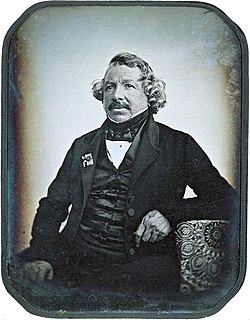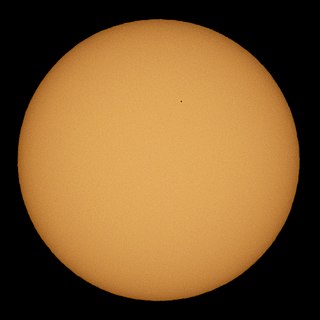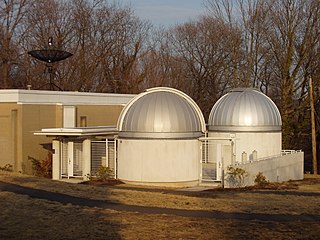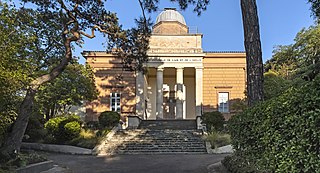Related Research Articles
The 22nd (twenty-second) century is the next century in the Anno Domini or Common Era in accordance with the Gregorian calendar. It will begin on January 1, 2101, and will end on December 31, 2200.

The daguerreotype process, or daguerreotypy, was the first publicly available photographic process, widely used during the 1840s and 1850s.

Yerkes Observatory is an astronomical observatory located in Williams Bay, Wisconsin, U.S.A. It was operated by the University of Chicago Department of Astronomy and Astrophysics from its founding in 1897 to 2020. Ownership was transferred to the non-profit Yerkes Future Foundation (YFF) in May, 2020.

Henry Draper was an American doctor and amateur astronomer. He is best known today as a pioneer of astrophotography.

Pierre Jules César Janssen, also known as Jules Janssen, was a French astronomer who, along with English scientist Joseph Norman Lockyer, is credited with discovering the gaseous nature of the solar chromosphere, and with some justification the element helium.

A transit of Mercury across the Sun takes place when the planet Mercury passes directly (transits) between the Sun and a superior planet, becoming visible against the solar disk. During a transit, Mercury appears as a tiny black dot moving across the disk of the Sun.
Guillaume Joseph Hyacinthe Jean-Baptiste Le Gentil de la Galaisière was a French astronomer who discovered several nebulae and was appointed to the Royal Academy of Sciences. He made unsuccessful attempts to observe the 1761 and 1769 transits of Venus from India.

Precursors of film are concepts and devices that have much in common with the later art and techniques of cinema.

The Yale University Observatory, also known as the Leitner Family Observatory and Planetarium, is an astronomical observatory owned and operated by Yale University, and maintained for student use. It is located in Farnham Memorial Gardens near the corner of Edwards and Prospect Streets, New Haven, Connecticut.
The decade of the 1870s in film involved some significant events.

The chronophotographic gun is one of the ancestors of the movie camera. It was invented in 1882 by Étienne-Jules Marey, a french scientist and chronophotograph. It could shoot 12 images per second and it was the first invention to capture moving images on the same chronomatographic plate using a metal shutter.

The Toulouse Observatory is located in Toulouse, France and was established in 1733.

The Horse in Motion is a series of cabinet cards by Eadweard Muybridge, including six cards that each show a sequential series of six to twelve "automatic electro-photographs" depicting the movement of a horse. Muybridge shot the photographs in June 1878. An additional card reprinted the single image of the horse "Occident" trotting at high speed, which had previously been published by Muybridge in 1877.

The 1874 Transit of Venus Expedition to Campbell Island was an astronomical expedition by French scientists to observe 9 December 1874 transit of Venus on subantarctic Campbell Island in the Southern Ocean some 600 km south of New Zealand. It was one of several such scientific expeditions from various countries sent around the world to observe the rare astronomical event.

The 1874 transit of Venus, which took place on 9 December 1874, was the first of the pair of transits of Venus that took place in the 19th century, with the second transit occurring eight years later in 1882. The previous pair of transits had taken place in 1761 and 1769, and the next pair would not take place until 2004 and 2012. As with previous transits, the 1874 transit would provide an opportunity for improved measurements and observations. Numerous expeditions were planned and sent out to observe the transit from locations around the globe, with several countries setting up official committees to organise the planning.

The 1882 transit of Venus, which took place on 6 December 1882, was the second and last transit of Venus of the 19th century, the first having taken place eight years earlier in 1874. Many an expedition was sent by European powers to describe both episodes, eight of them alone were approved and financed in 1882 by the United States Congress.
Not to be confused with: the Belgian mathematician Modeste Stuyvaert
Damnation du docteur Faust, released in the United States as Faust and Marguerite and in the United Kingdom as Faust, is a 1904 French silent film directed by Georges Méliès.
The Janssen revolver or Photo Revolver was invented by the French astronomer Pierre Jules César Janssen in 1874. It was the instrument that originated chronophotography, a branch of photography based on capturing movement from a sequence of images. To create the apparatus Pierre Janssen was inspired by the revolving cylinder of Samuel Colt's revolver.

John Moran was a pioneering American photographer and artist. Moran was a prominent landscape, architectural, astronomical and expedition photographer whose career began in the Philadelphia, Pennsylvania area during the 1860s.
References
- ↑ Doucet, Jean-François. "La "photographie du temps" avant le cinéma" ["Time photography" before cinema]. www.jf-doucet.com (in French). Retrieved 2016-02-20.
- ↑ "The 1874 Transit of Venus Observed in Japan by the French, and Associated Relics". adsabs.harvard.edu. Retrieved 2016-08-01.
- ↑ "The Brazilian contribution to the observation of the transit of Venus". adsabs.harvard.edu.
- ↑ http://adsbit.harvard.edu//full/2005JHA....36...57L/0000070.000.html